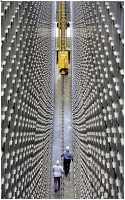 A key reason for the implementation of robots in Chicago State University after a careful evaluation of student needs by the school officials was the desire to save students time. Mr Crank stated that ” “We discovered that the average student took 30 minutes to find a book. Books would be misplaced or not filed correctly,”… “That’s a lot of time that cuts into how long students can spend analyzing the material, focusing on work, or continuing to find even more research on a particular subject.” Read the article here
A key reason for the implementation of robots in Chicago State University after a careful evaluation of student needs by the school officials was the desire to save students time. Mr Crank stated that ” “We discovered that the average student took 30 minutes to find a book. Books would be misplaced or not filed correctly,”… “That’s a lot of time that cuts into how long students can spend analyzing the material, focusing on work, or continuing to find even more research on a particular subject.” Read the article here
How does it work? Library staff at University of Missouri-Kansas City (UMKC) loaded books and other items into hundreds of bins, each of which has a cubbyhole in one of several four-story steel structures. Each item is tagged with a radio frequency ID chip. When students want a book a 58-foot robotic crane zooms down a narrow passageway between the structures, finds and pulls the bin and delivers it to a docking station and librarian. The process takes less than four minutes. Read more about how this works here
The robotic system saves space, which means libraries can house more spaces for students, including study rooms, meeting spaces, computer labs etc . This system enables better climate control for the collection and reduces the threat of theft. Plus the books don’t need to be stored in subject order because the computer keeps track of all the items.
What are the disadvantages? There are no more shelves of books to browse, which means you can’t take your time selecting a book whilst browsing along the shelves. In a time poor world though its likely that less and less patrons have the time or inclination to do this anymore. Read more on the advantages and disadvantages of the robotic library.
So far 17 libraries in North America are using this system. With libraries needing more space and yet housing more items than ever before this system is likely to become even more popular.
Discover more from Charles Sturt University Library Blog
Subscribe to get the latest posts sent to your email.